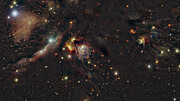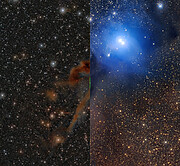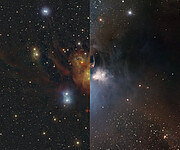Persbericht
ESO-telescoop legt enorme stellaire kweekvijvers bloot
11 mei 2023
Met behulp van ESO’s Visible and Infrared Survey Telescope for Astronomy (VISTA) hebben astronomen een uitgebreide infraroodatlas gemaakt van vijf nabijgelegen stellaire kraamkamers. Daartoe hebben ze meer dan een miljoen afzonderlijke opnamen samengevoegd. Op de grote mozaïeken zijn jonge sterren-in-wording te zien, ingebed in dikke stofwolken. Dankzij deze waarnemingen beschikken astronomen over een uniek hulpmiddel om het ingewikkelde vraagstuk van de geboorte van sterren te ontcijferen.
‘Op deze beelden kunnen we zelfs de zwakste lichtbronnen detecteren, zoals sterren met een veel geringere massa dan de zon, waardoor objecten zichtbaar worden die niemand ooit eerder heeft gezien,’ zegt Stefan Meingast, astronoom aan de Universiteit van Wenen (Oostenrijk) en hoofdauteur van de nieuwe studie die vandaag in Astronomy & Astrophysics is gepubliceerd. ‘Zo krijgen we inzicht in de processen die gas en stof omzetten in sterren.’
Sterren ontstaan wanneer wolken van gas en stof onder hun eigen zwaartekracht samentrekken, maar de details van hoe dit gebeurt worden niet volledig begrepen. Hoeveel sterren worden er uit een wolk geboren? Hoe zwaar zijn ze? Hoeveel sterren zullen ook planeten hebben?
Om deze vragen te beantwoorden, heeft het team van Meingast vijf nabije stervormingsgebieden onderzocht met de VISTA-telescoop van de ESO-sterrenwacht op Paranal (Chili). Met VISTA’s infraroodcamera VIRCAM ving het team licht op dat diep uit de stofwolken afkomstig was. ‘Het stof onttrekt deze jonge sterren aan ons zicht, waardoor ze voor onze ogen vrijwel onzichtbaar zijn. Alleen op infrarode golflengten kunnen we diep in deze wolken kijken en de sterren-in-wording bestuderen,’ verklaart Alena Rottensteiner, eveneens promovenda aan de Universiteit van Wenen en medeauteur van de studie.
Bij het onderzoek, VISIONS geheten, zijn stervormingsgebieden onder de loep genomen in de sterrenbeelden Orion, Slangendrager, Kameleon, Zuiderkroon en Wolf. Deze gebieden zijn minder dan 1500 lichtjaar van ons verwijderd en beslaan een enorm stuk hemel. Het gezichtsveld van VIRCAM is zo groot als drie volle manen, wat deze camera bij uitstek geschikt maakt voor het in kaart brengen van zulke immens grote gebieden.
Verspreid over een periode van vijf jaar heeft het team meer dan een miljoen opnamen gemaakt. De afzonderlijke beelden werden vervolgens samengevoegd tot de hier gepresenteerde grote mozaïeken met hun uitgestrekte kosmische ‘landschappen’. Op de detailrijke panorama’s zijn donkere stofconcentraties, gloeiende wolken, pasgeboren sterren en de verre achtergrondsterren van de Melkweg herkenbaar.
Omdat elk gebied meerdere keren is gefotografeerd, kunnen astronomen met de VISIONS-gegevens ook de bewegingen van jonge sterren onderzoeken. ‘Met VISIONS volgen we deze babysterren jaren achtereen, waardoor we hun verplaatsingen kunnen meten, en te weten komen hoe ze hun moederwolken verlaten,’ legt João Alves – astronoom aan de Universiteit van Wenen en hoofdonderzoeker van VISIONS – uit. Dat is geen gemakkelijke opgave, omdat de schijnbare verplaatsing van deze sterren vanaf de aarde gezien zo klein is als de breedte van een mensenhaar op tien kilometer afstand. Deze metingen van de sterbewegingen vormen een aanvulling op de metingen van de Gaia-missie van het Europese ruimteagentschap ESA op zichtbare golflengten, waarop jonge sterren vanwege het vele stof in hun omgeving niet te zien zijn.
Astronomen zullen nog jaren plezier hebben van de VISIONS-atlas. ‘De waarde voor de astronomische gemeenschap is groot en langdurig, en dat is precies de reden waarom ESO aanstuurt op openbare surveys zoals VISIONS,’ zegt Monika Petr-Gotzens, astronoom bij ESO in Garching (Duitsland), en medeauteur van deze studie. Bovendien zal VISIONS de basis leggen voor toekomstige waarnemingen met andere telescopen, zoals ESO’s Extremely Large Telescope (ELT), die momenteel in Chili wordt gebouwd en later dit decennium operationeel moet worden. ‘Met de ELT kunnen we ongekend nauwkeurig inzoomen op specifieke gebieden, waardoor we de afzonderlijke sterren die daar momenteel worden gevormd van dichterbij kunnen bekijken dan ooit tevoren,’ concludeert Meingast.
Meer informatie
De resultaten van dit onderzoek zijn te vinden in het artikel ‘VISIONS: The VISTA Star Formation Atlas’, dat in Astronomy & Astrophysics verschijnt (doi: XXX).
Het onderzoeksteam bestaat uit Stefan Meingast (Universiteit van Wenen, Oostenrijk [Wenen]), João Alves (Wenen), Hervé Bouy (Universiteit van Bordeaux, Frankrijk [Bordeaux]), Monika G. Petr-Gotzens (European Southern Observatory, Duitsland [ESO]), Verena Fürnkranz (Max-Planck-Institut für Astronomie, Duitsland [MPIA]]), Josefa E. Großschedl (Wenen), David Hernandez (Wenen), Alena Rottensteiner (Wenen), Joana Ascenso (Universiteit van Porto, Portugal [Porto]; Universiteit van Lissabon, Portugal [Lissabon]), Amelia Bayo (ESO; Universiteit van Valparaíso, Chili), Erik Brändli (Wenen), Anthony G.A. Brown (Sterrewacht Leiden), Jan Forbrich (Universiteit van Hertfordshire, VK [Hertfordshire]), Alyssa Goodman (Harvard-Smithsonian Center for Astrophysics, VS [CfA]), Alvaro Hacar (Wenen), Birgit Hasenberger (Wenen), Rainer Köhler (The CHARA Array of Georgia State University, VS), Karolina Kubiak (Lissabon), Michael Kuhn (Hertfordshire), Charles Lada (CfA), Kieran Leschinski (Wenen), Marco Lombardi (Universiteit van Milaan, Italië), Diego Mardones (Universiteit van Chili, Chili), Núria Miret-Roig (European Space Agency, European Space Research and Technology Centre, Nederland [ESA]), André Moitinho (Lissabon), Koraljka Mužiiić (Porto; Lissabon), Martin Piecka (Wenen), Laura Posch (Wenen), Timo Prusti (ESA), Karla Peña Ramírez (Universiteit van Antofagasta, Chili), Ronny Ramlau (Johannes Kepler Universiteit Linz, Oostenrijk; Johann Radon Institute for Computational and Applied Mathematics, Oostenrijk), Sebastian Ratzenböck (Wenen; Research Network Data Science van de Universiteit Wenen), Germano Sacco (INAF – Osservatorio Astrofisico di Arcetri, Italië), Cameren Swiggum (Wenen), Paula Stella Teixeira (Universiteit van St Andrews, VK), Vanessa Urban (Wenen), Eleonora Zari (MPIA) en Catherine Zucker (Bordeaux).
De Europese Zuidelijke Sterrenwacht (ESO) stelt wetenschappers van over de hele wereld in staat om de geheimen van het heelal te ontdekken, ten bate van iedereen. Wij ontwerpen, bouwen en exploiteren observatoria van wereldklasse die door astronomen worden gebruikt om spannende vragen te beantwoorden en de fascinatie voor astronomie te verspreiden, en bevorderen internationale samenwerking op het gebied van de astronomie. ESO, in 1962 opgericht als intergouvernementele organisatie, wordt inmiddels gedragen door 16 lidstaten (België, Denemarken, Duitsland, Finland, Frankrijk, Ierland, Italië, Nederland, Oostenrijk, Polen, Portugal, Spanje, Tsjechië, het Verenigd Koninkrijk, Zweden en Zwitserland) en door het gastland Chili, met Australië als strategische partner. Het hoofdkwartier van de ESO en haar bezoekerscentrum en planetarium, de ESO Supernova, zijn gevestigd nabij München in Duitsland, maar onze telescopen staan opgesteld in de Chileense Atacama-woestijn – een prachtige plek met unieke omstandigheden voor het doen van hemelwaarnemingen. ESO exploiteert drie waarnemingslocaties: La Silla, Paranal en Chajnantor. Op Paranal staan ESO’s Very Large Telescope en Very Large Telescope Interferometer, evenals surveytelescopen zoals VISTA. Ook zal ESO op Paranal de Cherenkov Telescope Array South huisvesten en exploiteren – ’s werelds grootste en gevoeligste observatorium van gammastraling. Samen met internationale partners beheert ESO APEX en ALMA op Chajnantor, twee faciliteiten die de hemel waarnemen in het millimeter- en submillimetergebied. Op Cerro Armazones, nabij Paranal, bouwen wij ‘het grootste oog ter wereld’ – ESO’s Extremely Large Telescope. Vanuit onze kantoren in Santiago, Chili, ondersteunen wij onze activiteiten in het gastland en werken wij samen met Chileense partners en de Chileense samenleving.
Links
• Voor journalisten: abonneer je op persberichten in je eigen taal
• Voor wetenschappers: heb je een verhaal? Promoot je onderzoek!
Contact
Stefan Meingast
University of Vienna
Vienna, Austria
E-mail: stefan.meingast@univie.ac.at
Juan Carlos Muñoz Mateos
ESO Media Officer
Garching bei München, Germany
Tel: +49 89 3200 6176
E-mail: press@eso.org
Rodrigo Alvarez (press contact België)
ESO Science Outreach Network
en Planetarium, Royal Observatory of Belgium
Tel: +32-2-474 70 50
E-mail: eson-belgië@eso.org
Over dit bericht
| Persberichten nr.: | eso2307nl-be |
| Type: | Milky Way : Nebula : Type : Star Formation |
| Facility: | Visible and Infrared Survey Telescope for Astronomy |
| Instruments: | VIRCAM |
| Science data: | 2023A&A...673A..58M |














